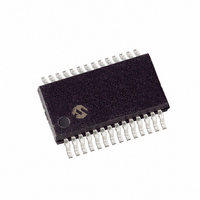PIC18F25J10-I/SS Microchip Technology, PIC18F25J10-I/SS Datasheet - Page 244

PIC18F25J10-I/SS
Manufacturer Part Number
PIC18F25J10-I/SS
Description
IC PIC MCU FLASH 16KX16 28SSOP
Manufacturer
Microchip Technology
Series
PIC® 18Fr
Datasheets
1.PIC16F616T-ISL.pdf
(8 pages)
2.PIC18F24J10-ISO.pdf
(368 pages)
3.PIC18F24J10-ISO.pdf
(6 pages)
4.PIC18F24J10-ISO.pdf
(6 pages)
5.PIC18F24J10-ISO.pdf
(12 pages)
6.PIC18LF24J10-ISS.pdf
(32 pages)
7.PIC18F45J10-IPT.pdf
(362 pages)
Specifications of PIC18F25J10-I/SS
Core Size
8-Bit
Program Memory Size
32KB (16K x 16)
Peripherals
Brown-out Detect/Reset, POR, PWM, WDT
Core Processor
PIC
Speed
40MHz
Connectivity
I²C, SPI, UART/USART
Number Of I /o
21
Program Memory Type
FLASH
Ram Size
1K x 8
Voltage - Supply (vcc/vdd)
2.7 V ~ 3.6 V
Data Converters
A/D 10x10b
Oscillator Type
Internal
Operating Temperature
-40°C ~ 85°C
Package / Case
28-SSOP
Controller Family/series
PIC18
No. Of I/o's
21
Ram Memory Size
1KB
Cpu Speed
40MHz
No. Of Timers
3
Processor Series
PIC18F
Core
PIC
Data Bus Width
8 bit
Data Ram Size
1 KB
Interface Type
SPIC, I2C, EUSART
Maximum Clock Frequency
40 MHz
Number Of Programmable I/os
21
Number Of Timers
3
Maximum Operating Temperature
+ 85 C
Mounting Style
SMD/SMT
3rd Party Development Tools
52715-96, 52716-328, 52717-734, 52712-325, EWPIC18
Development Tools By Supplier
PG164130, DV164035, DV244005, DV164005, PG164120, DM183022, DM183032, DV164136
Minimum Operating Temperature
- 40 C
On-chip Adc
10 bit, 10 Channel
Package
28SSOP
Device Core
PIC
Family Name
PIC18
Maximum Speed
40 MHz
Operating Supply Voltage
5 V
Lead Free Status / RoHS Status
Lead free / RoHS Compliant
For Use With
AC162074 - HEADER INTRFC MPLAB ICD2 44TQFPMA180011 - MODULE PLUG-IN 18F25J10 28SOICAC162067 - HEADER INTRFC MPLAB ICD2 40/28PAC164331 - MODULE SKT FOR 28SSOP 18F45J10XLT28SS-1 - SOCKET TRANSITION ICE 28SSOP
Eeprom Size
-
Lead Free Status / Rohs Status
Details
Available stocks
Company
Part Number
Manufacturer
Quantity
Price
Part Number:
PIC18F25J10-I/SS
Manufacturer:
MICROCHIP/微芯
Quantity:
20 000
- PIC16F616T-ISL PDF datasheet
- PIC18F24J10-ISO PDF datasheet #2
- PIC18F24J10-ISO PDF datasheet #3
- PIC18F24J10-ISO PDF datasheet #4
- PIC18F24J10-ISO PDF datasheet #5
- PIC18LF24J10-ISS PDF datasheet #6
- PIC18F45J10-IPT PDF datasheet #7
- Current page: 244 of 362
- Download datasheet (6Mb)
PIC18F45J10 FAMILY
FIGURE 20-5:
20.5.3
By entering a power-managed mode, the clock
multiplexor selects the clock source selected by the
OSCCON register. Fail-Safe Monitoring of the
power-managed
power-managed mode.
If an oscillator failure occurs during power-managed
operation, the subsequent events depend on whether
or not the oscillator failure interrupt is enabled. If
enabled (OSCFIF = 1), code execution will be clocked
by the INTOSC multiplexor. An automatic transition
back to the failed clock source will not occur.
If the interrupt is disabled, subsequent interrupts while
in Idle mode will cause the CPU to begin executing
instructions while being clocked by the INTOSC
source.
DS39682D-page 242
Note:
Sample Clock
CM Output
FSCM INTERRUPTS IN
POWER-MANAGED MODES
OSCFIF
Device
Output
Clock
The device clock is normally at a much higher frequency than the sample clock. The relative frequencies in
this example have been chosen for clarity.
(Q)
clock
FSCM TIMING DIAGRAM
source
resumes
CM Test
in
the
20.5.4
The FSCM is designed to detect oscillator failure at any
point after the device has exited Power-on Reset
(POR) or low-power Sleep mode. When the primary
device clock is either EC or INTRC modes, monitoring
can begin immediately following these events.
For HS mode, the situation is somewhat different.
Since the oscillator may require a start-up time consid-
erably longer than the FSCM sample clock time, a false
clock failure may be detected. To prevent this, the
internal oscillator block is automatically configured as
the device clock and functions until the primary clock is
stable (the OST timer has timed out). This is identical
to Two-Speed Start-up mode. Once the primary clock is
stable, the INTRC returns to its role as the FSCM
source.
As noted in Section 20.4.1 “Special Considerations
for Using Two-Speed Start-up”, it is also possible to
select another clock configuration and enter an alternate
power-managed mode while waiting for the primary
clock to become stable. When the new power-managed
mode is selected, the primary clock is disabled.
Note:
CM Test
Oscillator
Failure
POR OR WAKE-UP FROM SLEEP
The same logic that prevents false oscilla-
tor failure interrupts on POR, or wake from
Sleep, will also prevent the detection of
the oscillator’s failure to start at all
following these events. This can be
avoided by monitoring the OSTS bit and
using a timing routine to determine if the
oscillator is taking too long to start. Even
so, no oscillator failure interrupt will be
flagged.
© 2008 Microchip Technology Inc.
Detected
Failure
CM Test
Related parts for PIC18F25J10-I/SS
Image
Part Number
Description
Manufacturer
Datasheet
Request
R

Part Number:
Description:
Manufacturer:
Microchip Technology Inc.
Datasheet:

Part Number:
Description:
Manufacturer:
Microchip Technology Inc.
Datasheet:

Part Number:
Description:
Manufacturer:
Microchip Technology Inc.
Datasheet:

Part Number:
Description:
Manufacturer:
Microchip Technology Inc.
Datasheet:

Part Number:
Description:
Manufacturer:
Microchip Technology Inc.
Datasheet:

Part Number:
Description:
Manufacturer:
Microchip Technology Inc.
Datasheet:

Part Number:
Description:
Manufacturer:
Microchip Technology Inc.
Datasheet:

Part Number:
Description:
Manufacturer:
Microchip Technology Inc.
Datasheet:











